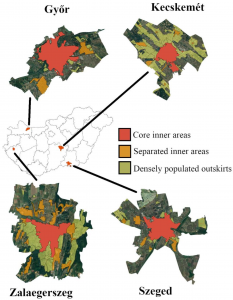Suburbanization within City Limits in Hungary
— A Challenge for Environmental and Social Sustainability
by Gábor László Vasárus and József Lennert
Institute for Regional Studies,
Centre for Economic and Regional Studies,
Kecskemét, Hungary
Centre for Economic and Regional Studies,
Kecskemét, Hungary

Sustainability 2022, 14(14), 8855
Published: 20 July 2022
This article belongs to the Section Sustainable Urban and Rural Development.
Abstract
Suburbanization is one of the most prominent processes of post-socialist urban development, leading to the deconcentration of people, capital, as well as productive and non-productive activities within the functional urban area.  This phenomenon also has a significant impact on the traditional rural landscape and leads to environmental and social sustainability challenges. Outmigration from the city center to the rural municipalities of the agglomeration ring is already a thoroughly studied topic. However, less attention is given to migration processes not crossing municipal borders.
This phenomenon also has a significant impact on the traditional rural landscape and leads to environmental and social sustainability challenges. Outmigration from the city center to the rural municipalities of the agglomeration ring is already a thoroughly studied topic. However, less attention is given to migration processes not crossing municipal borders.  In Hungary, a significant fraction of them is driven by similar motivations as “traditional” suburbanization. Such movements include flows to built-up residential areas that are physically separated from the urban core. Due to their peculiar development path, the inhabited outskirts can also become destinations for within-city migration. This kind of mobility can be considered suburbanization within the city limits. Because of the general lack of data, this phenomenon is seldom researched. However, this study attempts to address this gap. The prevalence of this process in Hungary is explored by analyzing national statistical data sources. Four case studies are selected for detailed examination—Győr, Zalaegerszeg, Kecskemét, and Szeged. GIS methods, field examinations, surveys, and expert interviews are used to get a detailed picture of the demographic and land cover change processes, as well as the distinctions between the destination areas of the case studies. A comparison of the results drawn from the different methods reveals that land use change in the study area is more widespread than what the land cover datasets indicate. The findings indicate that the Corine Land Cover categories describing mixed land use—especially complex cultivation patterns—are not able to capture the drastic function shift caused by intense suburbanization. Different environmental and social sustainability issues are identified depending on the economic status of the outmigrants. This paper also sheds some light on the urban planning considerations of this emerging challenge.
In Hungary, a significant fraction of them is driven by similar motivations as “traditional” suburbanization. Such movements include flows to built-up residential areas that are physically separated from the urban core. Due to their peculiar development path, the inhabited outskirts can also become destinations for within-city migration. This kind of mobility can be considered suburbanization within the city limits. Because of the general lack of data, this phenomenon is seldom researched. However, this study attempts to address this gap. The prevalence of this process in Hungary is explored by analyzing national statistical data sources. Four case studies are selected for detailed examination—Győr, Zalaegerszeg, Kecskemét, and Szeged. GIS methods, field examinations, surveys, and expert interviews are used to get a detailed picture of the demographic and land cover change processes, as well as the distinctions between the destination areas of the case studies. A comparison of the results drawn from the different methods reveals that land use change in the study area is more widespread than what the land cover datasets indicate. The findings indicate that the Corine Land Cover categories describing mixed land use—especially complex cultivation patterns—are not able to capture the drastic function shift caused by intense suburbanization. Different environmental and social sustainability issues are identified depending on the economic status of the outmigrants. This paper also sheds some light on the urban planning considerations of this emerging challenge.
 This phenomenon also has a significant impact on the traditional rural landscape and leads to environmental and social sustainability challenges. Outmigration from the city center to the rural municipalities of the agglomeration ring is already a thoroughly studied topic. However, less attention is given to migration processes not crossing municipal borders.
This phenomenon also has a significant impact on the traditional rural landscape and leads to environmental and social sustainability challenges. Outmigration from the city center to the rural municipalities of the agglomeration ring is already a thoroughly studied topic. However, less attention is given to migration processes not crossing municipal borders.  In Hungary, a significant fraction of them is driven by similar motivations as “traditional” suburbanization. Such movements include flows to built-up residential areas that are physically separated from the urban core. Due to their peculiar development path, the inhabited outskirts can also become destinations for within-city migration. This kind of mobility can be considered suburbanization within the city limits. Because of the general lack of data, this phenomenon is seldom researched. However, this study attempts to address this gap. The prevalence of this process in Hungary is explored by analyzing national statistical data sources. Four case studies are selected for detailed examination—Győr, Zalaegerszeg, Kecskemét, and Szeged. GIS methods, field examinations, surveys, and expert interviews are used to get a detailed picture of the demographic and land cover change processes, as well as the distinctions between the destination areas of the case studies. A comparison of the results drawn from the different methods reveals that land use change in the study area is more widespread than what the land cover datasets indicate. The findings indicate that the Corine Land Cover categories describing mixed land use—especially complex cultivation patterns—are not able to capture the drastic function shift caused by intense suburbanization. Different environmental and social sustainability issues are identified depending on the economic status of the outmigrants. This paper also sheds some light on the urban planning considerations of this emerging challenge.
In Hungary, a significant fraction of them is driven by similar motivations as “traditional” suburbanization. Such movements include flows to built-up residential areas that are physically separated from the urban core. Due to their peculiar development path, the inhabited outskirts can also become destinations for within-city migration. This kind of mobility can be considered suburbanization within the city limits. Because of the general lack of data, this phenomenon is seldom researched. However, this study attempts to address this gap. The prevalence of this process in Hungary is explored by analyzing national statistical data sources. Four case studies are selected for detailed examination—Győr, Zalaegerszeg, Kecskemét, and Szeged. GIS methods, field examinations, surveys, and expert interviews are used to get a detailed picture of the demographic and land cover change processes, as well as the distinctions between the destination areas of the case studies. A comparison of the results drawn from the different methods reveals that land use change in the study area is more widespread than what the land cover datasets indicate. The findings indicate that the Corine Land Cover categories describing mixed land use—especially complex cultivation patterns—are not able to capture the drastic function shift caused by intense suburbanization. Different environmental and social sustainability issues are identified depending on the economic status of the outmigrants. This paper also sheds some light on the urban planning considerations of this emerging challenge.Keywords: suburbanization; post-socialist urbanization; migration within city limits; land cover change; urban sprawl; greenfield development degradation


